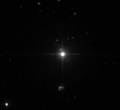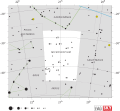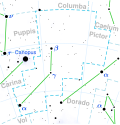AU Microscopii (AU Mic) is a young red dwarf star located 31.7 light-years (9.7 parsecs) away – about 8 times as far as the closest star after the Sun...
40 KB (3,392 words) - 11:18, 19 July 2024
Microscopium (redirect from Microscopii)
AU Microscopii and HD 205739—have been determined to have planets, while other star —the Sun-like star HD 202628— has a debris disk. AU Microscopii and...
26 KB (2,876 words) - 15:54, 27 September 2024
"A planet within the debris disk around the pre-main-sequence star AU Microscopii". Nature. 582 (7813): 497–500. arXiv:2006.13248. Bibcode:2020Natur.582...
141 KB (7,719 words) - 06:16, 11 November 2024
their brightness. This pair lies physically near the red dwarf star AU Microscopii, which may mean they form a wide triple star system. In 1926, Dutch-American...
14 KB (1,260 words) - 23:52, 26 July 2023
"A planet within the debris disk around the pre-main-sequence star AU Microscopii." Nature 582, no. 7813 (2020): 497-500. Günther, Maximilian N., Zhuchang...
28 KB (2,277 words) - 02:18, 26 November 2024
System. Most known debris disks have radii of 10–100 astronomical units (AU); they resemble the Kuiper belt in the Solar System, although the Kuiper belt...
27 KB (2,357 words) - 19:16, 17 July 2024
processes have been inferred in the debris disks around Fomalhaut and AU Microscopii. The spectrum of Beta Pictoris shows strong short-term variability that...
58 KB (6,140 words) - 22:53, 2 October 2024
first optical images of debris disks surrounding the nearby red dwarf AU Microscopii and the bright star Fomalhaut. Kalas' Hubble Space Telescope image of...
9 KB (839 words) - 16:32, 3 August 2024
or Flying Saucer Nebula). Other edge-on disks (e.g. Beta Pictoris or AU Microscopii) and face-on disks (e.g. IM Lupi or AB Aurigae) require a coronagraph...
29 KB (3,603 words) - 21:19, 1 October 2024
(2004-03-01). "Discovery of a Large Dust Disk Around the Nearby Star AU Microscopii". Science. 303 (5666): 1990–1992. arXiv:astro-ph/0403132. Bibcode:2004Sci...
86 KB (7,181 words) - 08:21, 19 November 2024
around Gliese 49 B M5V GJ 3988 32.30 ± 0.01 M5V has 1 known planet AU Microscopii 32.32 ± 0.33 Microscopium M1Ve 8.73 has 2-4 known planets HD 232979...
53 KB (2,039 words) - 16:08, 17 October 2024
as the largest EUV flare that had been observed at the time, seen on AU Microscopii in July 1992. HD 53680, HD 53705, and HD 53706: another quadruple system...
20 KB (1,435 words) - 18:42, 22 November 2024
A debris disk around the star AU Microscopii. The black circle in the center is an occulting disk of a coronagraph....
2 KB (147 words) - 08:15, 30 October 2023
A.; Waite, Ian A.; Kielkopf, John F. (1 December 2023). "Validating AU Microscopii d with Transit Timing Variations". The Astronomical Journal. 166 (6):...
177 KB (9,297 words) - 21:09, 2 November 2024
Beta Microscopii (Beta Mic), Latinized from β Microscopii, is a solitary star in the constellation Microscopium. It is close to the lower limit of stars...
13 KB (778 words) - 14:37, 5 February 2023
"A planet within the debris disk around the pre-main-sequence star AU Microscopii". Nature. 582 (7813): 497–500. arXiv:2006.13248. Bibcode:2020Natur.582...
179 KB (9,662 words) - 16:27, 23 July 2024
Laura; Kochukhov, Oleg (1 April 2022). "Simulating the Space Weather in the AU Mic System: Stellar Winds and Extreme Coronal Mass Ejections". The Astrophysical...
14 KB (1,483 words) - 20:13, 8 September 2024
with multiple transiting exoplanets, after HD 219134, LTT 1445, and AU Microscopii. Vallenari, A.; et al. (Gaia collaboration) (2023). "Gaia Data Release...
8 KB (538 words) - 20:07, 22 December 2023
smaller than 100 Myrs. Other examples are K2-33b, V1298 Tauri b and AU Microscopii b. Of these systems DS Tuc is the brightest and it is a good target...
15 KB (1,417 words) - 21:26, 30 July 2024
Circumstellar disk Protoplanetary disk Debris disk T Tauri star HD 74389 AU Microscopii List of nearby stellar associations and moving groups silverbergastro...
26 KB (2,712 words) - 23:02, 11 October 2024
Feldman (June 20, 2005). "Rapid Dissipation of Primordial Gas from the AU Microscopii Debris Disk". The Astrophysical Journal. 626 (2): L105–L108. arXiv:astro-ph/0505302...
14 KB (1,241 words) - 01:25, 7 April 2024
~20 Myr old AU Microscopii and the ~50 Myr old GJ 182, but smaller than the ~10 Myr old TWA 7. The disk has a radius smaller than 16 au. The missing...
10 KB (1,056 words) - 02:34, 19 July 2024
Eta Microscopii, Latinised as η Microscopii, is a solitary star in the constellation Microscopium. It is visible to the naked eye as a dim, orange-hued...
6 KB (589 words) - 00:15, 23 August 2024
ζ Microscopii, Latinised as Zeta Microscopii, is a solitary, yellow-white hued star in the southern constellation of Microscopium. It is faintly visible...
7 KB (504 words) - 10:01, 22 August 2024
δ Microscopii, Latinised as Delta Microscopii, is a faint, orange hued binary star system in the constellation Microscopium, marking the eyepiece end...
6 KB (418 words) - 06:51, 27 March 2022
4\left(M_{V_{\odot }}-M_{V_{\ast }}\right)}} = 0.005495 Lv⊙ Only AX Microscopii and Lacaille 9352, in the southern hemisphere, are brighter which would...
32 KB (3,037 words) - 05:23, 11 October 2024
/ˌmaɪkroʊˈskɒpiəm/ Mic Micr Microscopiae 1763, Lacaille microscope γ Microscopii 4.68 Monoceros /məˈnɒsɪrəs/ Mon Mono Monocerotis 1613, Plancius unicorn...
31 KB (848 words) - 05:00, 22 November 2024
of the Sun. It is currently predicted to pass 0.1696±0.0065 ly (10635±500 au) from the Sun in 1.290±0.04 million years from the present, close enough to...
116 KB (5,346 words) - 03:23, 11 November 2024
with the radiant point in the constellation of Microscopium, near alpha Microscopii. It could also be the parent body of γ-Bootids, a meteor shower whose...
15 KB (1,682 words) - 16:01, 5 November 2024
10 − 3 ) AU 0.0046491 AU / R ⨀ ≈ 2.17 ⋅ R ⨀ {\displaystyle {\begin{aligned}2\cdot R_{*}&={\frac {(54\cdot 0.187\cdot 10^{-3})\ {\text{AU}}}{0.0046491\...
18 KB (1,367 words) - 23:25, 28 February 2024



















